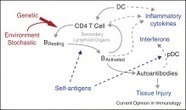Elevated concentrations of inflammatory mediators are characteristic of autoimmune disease accompanied by chronic or recurrent inflammation. We examined the hypothesis that mediators of inflammation known to be elevated in systemic lupus erythematosus (SLE) and rheumatoid arthritis (RA) are associated with genetic polymorphism previously identified in studies of inflammatory disease. Serum interleukin 6 (IL-6) and tumor necrosis factor alpha (TNFα) concentrations in patients with SLE (n = 117) or RA (n = 164) and in inflammatory disease-free control subjects (n = 172) were measured by multiplex ELISA. Candidate genes were chosen from studies of autoimmune and inflammatory disease. Genotypes were determined for 345 SNP markers in 75 genes. Association between serum analytes and single alleles was tested by linear regression. Polymorphisms in several genes were associated with IL-6 levels (including IL10, TYK2, and CD40L in SLE and DRB1, NOD2, and CSF1 in RA) or with TNFα levels (including TNFSF4 and CSF2 in SLE and PTPN2, DRB1, and NOD2 in RA). Some associations were shared between disease and control groups or between IL-6 and TNFα within a group.
In conclusion, variation in genes implicated in disease pathology is associated with serum IL-6 or TNFα concentration. Some genetic associations are more apparent in healthy controls than in SLE or RA, suggesting dysregulation of the principal mediators of chronic inflammation in disease. Susceptibility genes may affect inflammatory response with variable effect on disease etiology.
Via Edward NS, Krishan Maggon



 Your new post is loading...
Your new post is loading...













